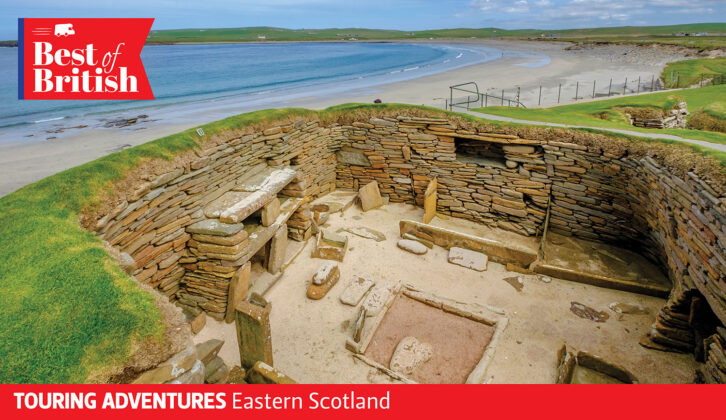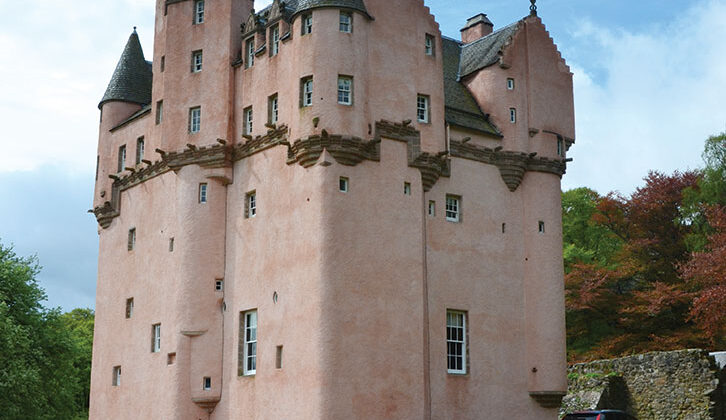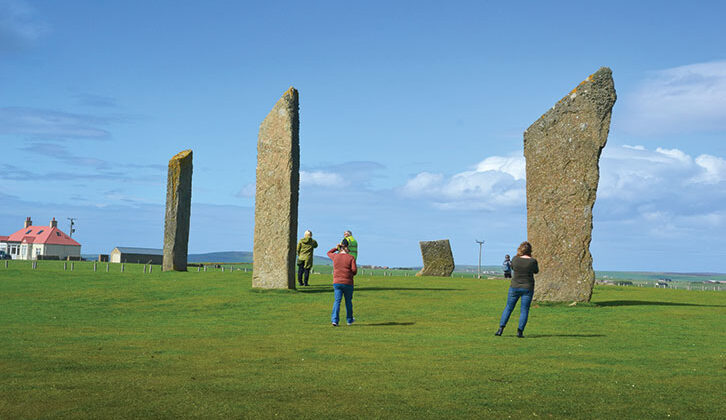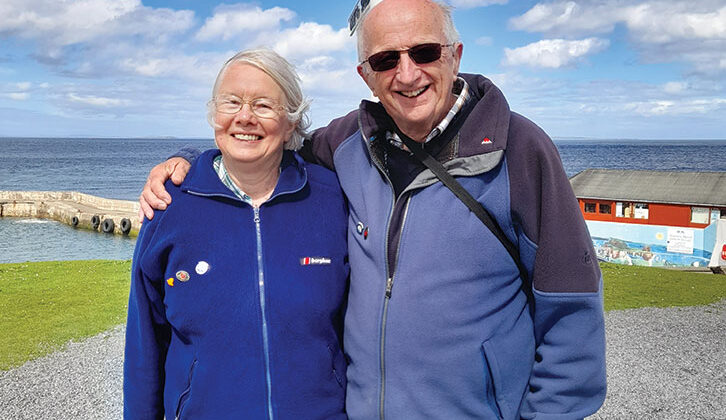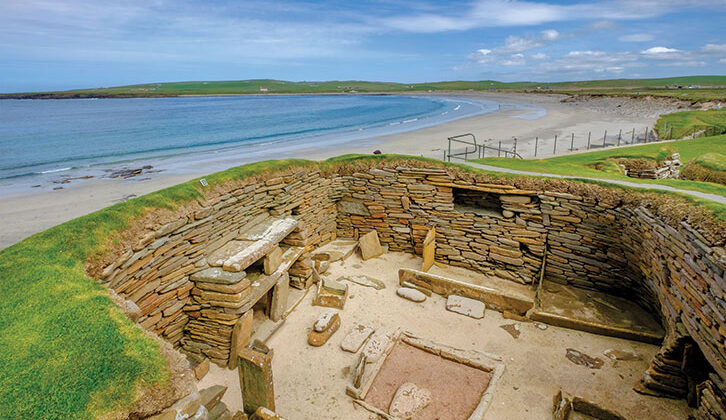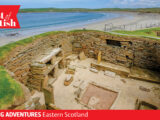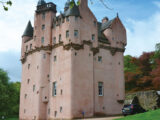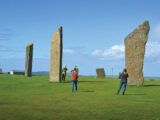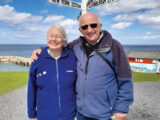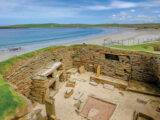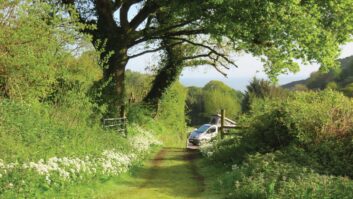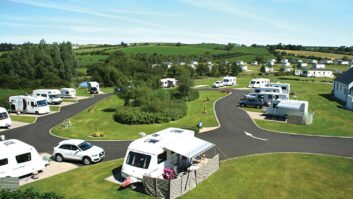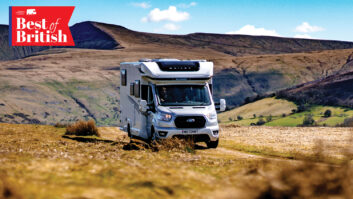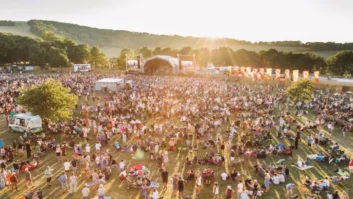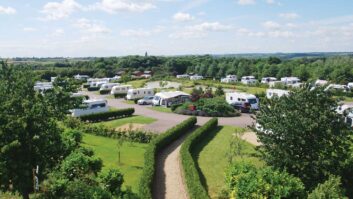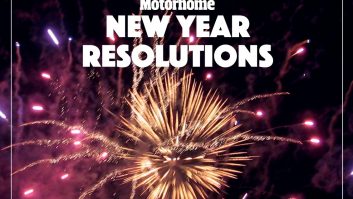I was chatting to a fellow camper, who said he always rushed up the eastern side of Scotland because there was nothing to see. Oh dear, I thought – our plan for this tour was to visit or stay mainly in the east on our trip!
We’d been on the lookout for the best motorhome site in Scotland for our needs, and decided on Strathclyde Caravan and Motorhome Club Site. Situated between Glasgow and Edinburgh, it’s ideal for visiting The Falkirk Wheel, a short drive away. The Wheel is one of only two working boat lifts in the UK and the only rotating boat lift in the world. It replaces a long-gone series of locks, and connects the Forth and Clyde Canal with the Union Canal.
If you’re thinking of visiting the beautiful country, the Stay the Night scheme could also offer a useful way of exploring Scotland. Run by Forestry and Land Scotland (FLS), it sees a single night stay permitted for motorhomes and campervans at 36 car parks – you can find out which car parks are participating on the FLS’ Stay the Night page.
Next day, we caught the first trip on a canal boat, which the Wheel lifts to the Union Canal above. After a brief journey through a tunnel, the boat turns, for a second trip on the Wheel.
There are great views from the top and on returning to the start, there’s a visitor centre and café, where we enjoyed lunch in the sunshine.
Nearby are The Kelpies, 30m-high horse head sculptures of stainless steel, celebrating the use of heavy horses in Scottish industry and agriculture, where they pulled barges and ploughs.
Search for fish and chips
We had now chosen another motorhome site, this time moving on to Stonehaven Caravan and Motorhome Club Site, just south of Aberdeen. Neither of us felt like making dinner, so we went into Stonehaven in search of the fish and chip shop recommended by the Hairy Bikers in one of their programmes.
Carron Fish Bar did not disappoint and we wolfed down our meal in the ’van. It also offers the famous fried Mars Bar if you dare (we didn’t).
Next day, we walked on the promenade and boardwalk adjoining the beach. There’s plenty of seating, and sculptures of boats, an aeroplane and a lighthouse fashioned out of scrap metal.
We arrived at the pretty harbour populated by leisure craft and a few fishing vessels, and lined with cafés, bars, pubs and restaurants. We sought a refreshing cuppa at the Old Pier Coffee House.
After lunch, we drove to the spectacular ruins of Dunnottar Castle. The surviving buildings are mainly 15th- or 16th-century and its main claim to fame is that Scotland’s Crown Jewels were once hidden here, well out of sight of the marauding soldiers of Oliver Cromwell’s army.
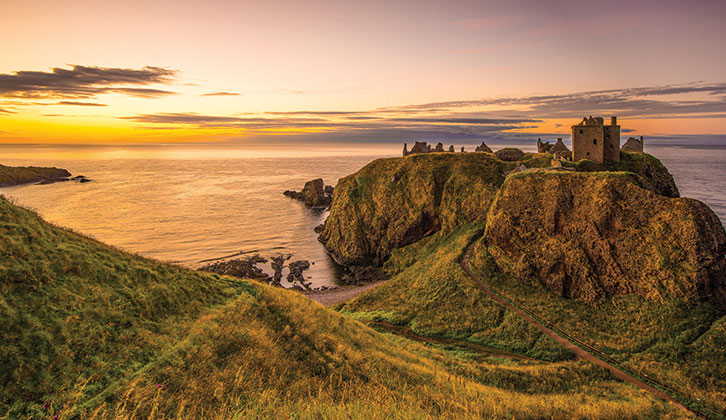
The coastal path here continues on towards Stonehaven and a fine War Memorial, designed like a Greek temple, honouring those from the town who fell in the world wars.
A couple of castles
Our next two days were spent visiting more castles, this time not ruins. First up was Crathes Castle, near Banchory, to the south-west of Aberdeen. It was completed in 1596 by Alexander Burnett and remained in the family until 1951, when it was given to the National Trust for Scotland. The castle features magnificent Scottish renaissance painted ceilings and original furniture from 1597. I voted it a real castle because it has two spiral staircases, but the correct name is a tower house. The grounds are extensive and there’s a lovely walled garden.
The second castle, Craigievar, due west of Aberdeen, is also a tower house, but it’s much more than that – it’s the fairy tale castle you imagined as a child.
Painted a distinctive pale pink in 1824, Craigievar Castle was built back in 1626 and remained home to the Forbes family until the 1960s, when it was acquired by the National Trust for Scotland.
Consequently, a great deal of the fittings and furniture are original and until fairly recently, there was no running water or electricity. There is still no electricity on the upper floor, where paintings by Sir Henry Raeburn are displayed. Craigievar has two spiral staircases, one of them also a secret staircase.
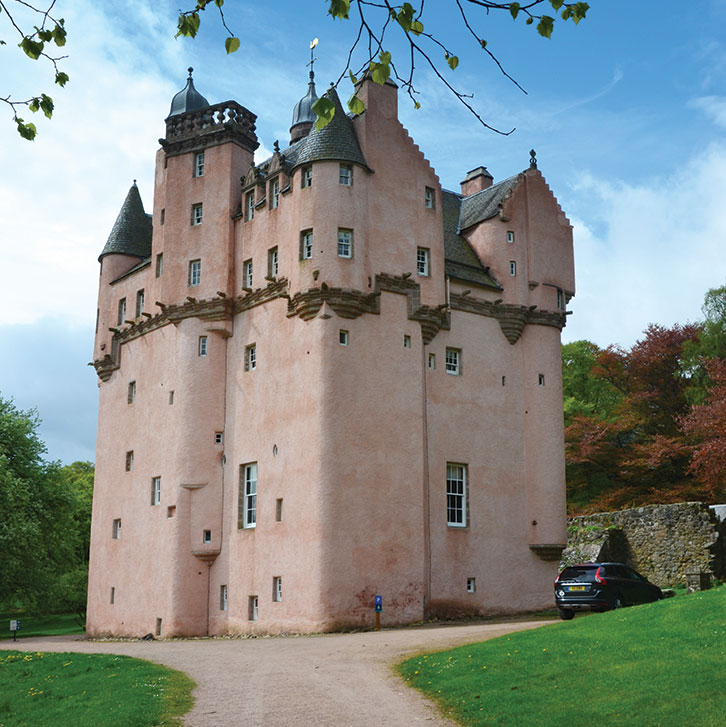
After an excellent meal at The Marine Hotel on Stonehaven harbour, we took our leave of this pretty seaside town and motored on to Culloden. We stayed briefly at Culloden Moor Caravan and Motorhome Club Site, purely to visit the site of the Battle of Culloden, east of Inverness.
We opted for the guided battlefield tour and our informative guide, Valerie, made the history of this large, open field really come to life.
Culloden was where the 1745 Jacobite Rising came to a terrible end. Jacobite supporters, led by Bonnie Prince Charlie, sought to restore the Stuart monarchy to the throne and, at Culloden on 16 April 1746, confronted government troops led by the Duke of Cumberland. In 45 minutes, the battle was over and out of the 1600 slain, 1500 were Jacobites. This was to be the last pitched battle on British soil.
After a snack at the café, we toured the informative visitor centre, reading in detail about the battle’s history.
Over to Orkney
Our next destination was Dunnet Bay Caravan and Motorhome Club Site in the north-east of Scotland, just a little west of John O’Groats. This grassy site borders a sandy beach.
Having checked the forecast, we booked a tour to the Orkney islands. On a gloriously sunny day, we took the MV Pentland Venture, a passenger ferry that plies the eight-mile journey between John O’ Groats and South Ronaldsay.
Coaches were waiting to take us to see key sites on the islands. We explored Scapa Flow, where in 1939 a German submarine infiltrated and sank the battleship HMS Royal Oak anchored there.
After that incident, four causeways, known as Churchill Barriers, were built, mainly by Italian POWs. These linked the Orkney mainland with South Ronaldsay via three smaller islands and prevented any further incursions. Today, there are road links between the islands.
We stopped at Kirkwall, the largest town in the Orkneys, where we were free to explore on our own. Joe and I headed for St Magnus Cathedral, an imposing edifice built in 1137 from red and yellow sandstone in the Romanesque style.
Nearby are the ruins of the Bishop’s Palace, and the Earl’s Palace, formerly belonging to the Earls of Orkney. After a cuppa, we strolled down the winding street to the harbour, where we stopped to admire the many leisure craft and fishing boats, with cruise ships anchored beyond.
Neolithic settlement
We left Kirkwall and drove by Scapa Flow to Stromness, where we lunched in the sunshine on buns and ice cream from Julia’s Café. Our next stop was Skara Brae, a Neolithic settlement of 10 houses made of flagstones and earth, occupied from around 3100 to 2500 BC.
Skara Brae was first revealed after a storm in 1850. It is described as Europe’s most complete Neolithic village and has UNESCO World Heritage status, together with other places in Orkney, such as the Ring of Brodgar, our next stop.
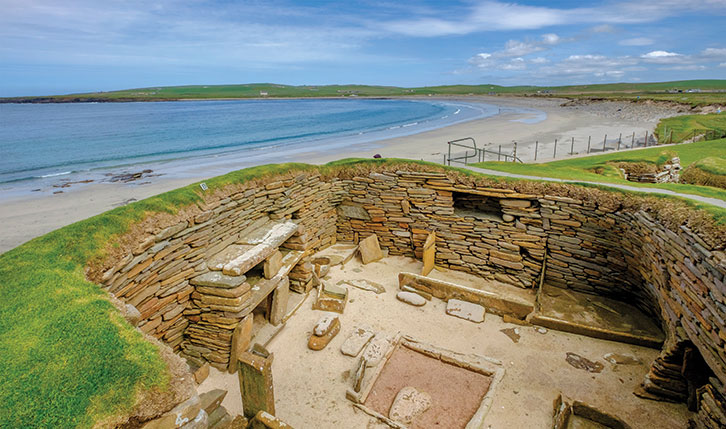
The Ring of Brodgar is a neolithic henge and stone circle comprising 60 stones, of which 36 survive today, and a large rock-cut ditch. There are many suggested explanations for its purpose, although nobody knows for sure.
We also stopped at the Standing Stones of Stenness, originally thought to number 11, but now with just four remaining.
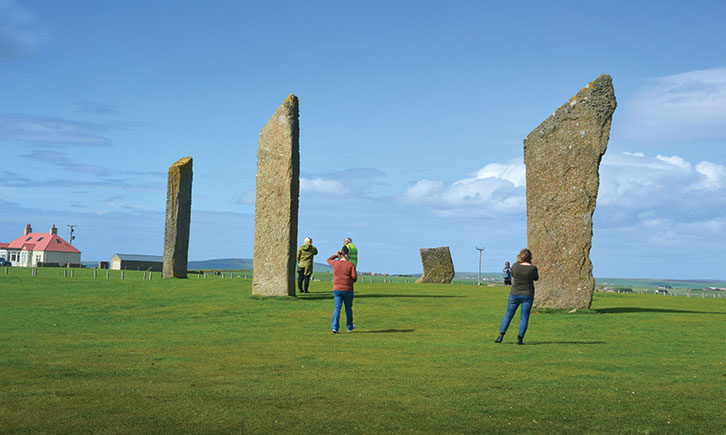
Our final stop was the Italian Chapel on the Island of Lamb Holm. This eye-catching building was constructed out of two Nissen huts, by Italian POWs held in Camp 60, who had helped to build the Churchill Barriers.
One of the prisoners was an artist, who directed the work. They only had scrap materials to work with, but the result is magnificent. Later on, we caught the ferry back to John O’Groats and had dinner at The Northern Point.
Dunnet all!
John O’ Groats itself is a small place. We got the obligatory photo under the famous signpost – which isn’t actually the northernmost point; that accolade goes to Dunnet Head. We then drove east to Duncansby Head, to see the lighthouse and the sandstone pyramids of Duncansby Stacks.
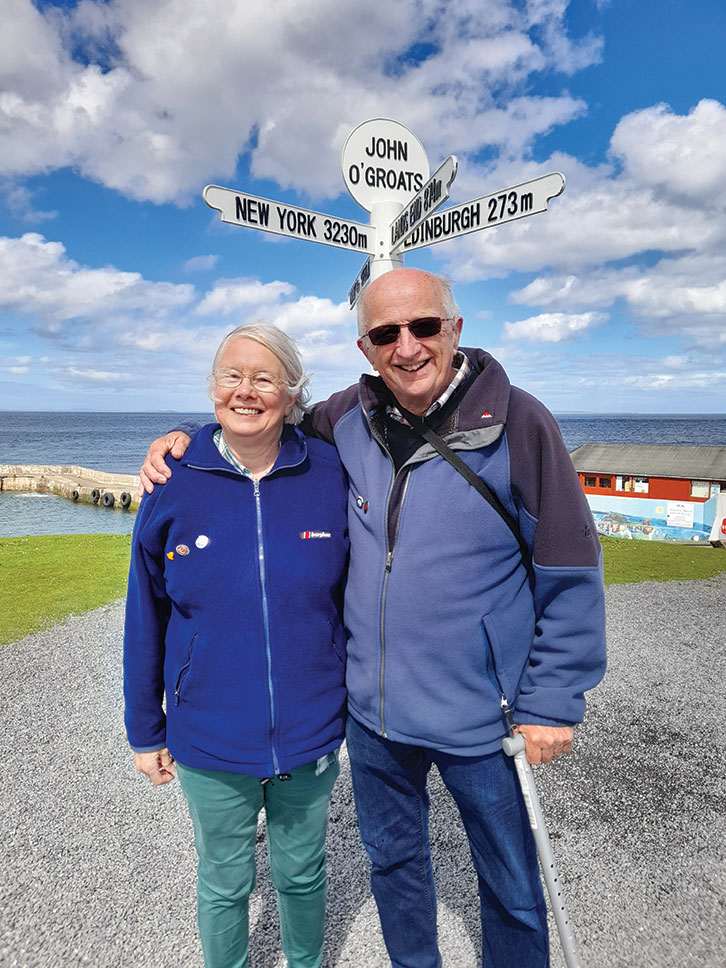
We continued along the east coast towards Wick, coming across more ruins. First was Keiss Castle, a tower house originally with four floors, an attic and a basement. Keiss village has a charmingly secluded harbour. Further down the coast, at Noss Head, you can see the dramatic ruins of Castle Sinclair Girnigoe, thought to be one of the earliest seats of Clan Sinclair.
Strolling around Wick, we came across a plaque marking the Guinness World Record for shortest street – Ebenezer Place measures just 6’ 9”.
Our final stop was Wick Castle, of which little remains. There is a pleasing coastal walk to its location, a dramatic spot above rocky cliffs.
We then cut across country, leaving the coast to go to Thurso. Notable places here are the ruined Old St Peter’s Kirk, founded around 1220 but closed since 1832, and the fishermen’s cottages.
We ended our stay at Dunnet with a good meal in the local hotel, Northern Sands. The sun was still shining when we emerged, so we turned down the next lane to Dunnet Head, to see the lighthouse. With the last rays disappearing, the views were stunning. These clifftops are also a good place for birdwatching. We even glimpsed the Old Man of Hoy in the distance.
Beautiful Brora Beach
It was time to move to our final stopping place on the east coast, Brora Caravan and Motorhome Club Site. This pretty campsite provides access to a golf course, dunes and beautiful Brora Beach.
Spotting a plan of Brora, we followed a trail around the village, which takes you past the fishermen’s cottages. You can also find out about the area’s once-thriving salt industry.
Returning to the square, we treated ourselves to delicious ice cream at Capaldis – don’t miss it! We also visited two historical sites north of the village, a broch and a Highland Clearance village.
A broch looks like an Iron Age roundhouse, but nobody is quite sure about their purpose. Ousedale Broch has now been restored, along with the path running downhill to reach it.
Highlands history
The Highland Clearance village of Badbea was a place where Highlanders were allocated land of a very poor quality after having been forcibly removed from their crofts.
The land was steep and extremely difficult to farm – in winter, for example, they had to tether their cattle for fear of losing them to the sea in the high winds! Many of the men took to fishing because the land was so bad.
There’s less and less of the village to see as time goes by, but I felt very sad for the crofters who had been treated so unfairly.
There’s another, bigger broch just south of Brora, visible from the A9, which we visited before continuing southwards to explore the magnificent Dunrobin Castle.
This is no ruin – quite the opposite, in fact. It has been continuously inhabited since the 1300s by the Earls and Dukes of Sutherland. The castle, styled like a French château, has no fewer than 189 rooms and is sumptuously decorated.
After our visit, we had hoped to watch a falconry display in the grounds, but it started to rain heavily, so now we know that falcons don’t like to fly in the rain…
A wonderful waterfall
Earlier, I’d spotted a signpost to Big Burn, near Golspie, and we wondered what it was. Some online research revealed a delightful walk, with a dramatic waterfall to be seen at the end of it.
The path follows the river, with bridges crossing it along the way. We’d recently had a lot of rain, so the waterfall was in spate and well worth the walk. On the way back, a splendid deer stopped to stare at us before disappearing. That really was the icing on the cake!
Next morning, at last, we had a decent day for cycling. We parked in Brora and then cycled up to Loch Brora and beyond. Later, we stopped for lunch by the river. After our fellow camper’s comments, we were relieved to find lots to enjoy on the east coast – and there was plenty more that we could have visited, given more time.
When to go to Eastern Scotland
May and June are usually the best months to visit, but be prepared – you can get all four seasons in one day!
Food and drink in Eastern Scotland
Find out more
Where we stayed in Eastern Scotland
Strathclyde Country Park CAMC Site
Bothwell G71 8NY
Stonehaven Queen Elizabeth Park CAMC Site
Stonehaven AB39 2RD
Newlands IV2 5LA
Dunnet KW14 8XD
Dalchalm KW9 6LP
Head to our Best of British: Touring Adventures category to find more great travel ideas and inspiration.
If you’ve enjoyed reading this, why not get the latest news, reviews and features delivered direct to your door or inbox every month. Take advantage of our brilliant Practical Motorhome magazine SUBSCRIBERS’ OFFER and SIGN UP TO OUR NEWSLETTER for regular weekly updates on all things motorhome related
